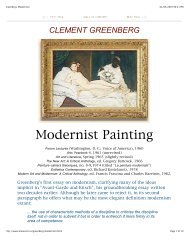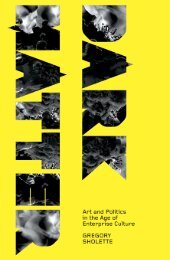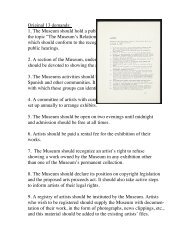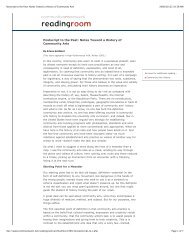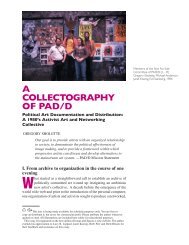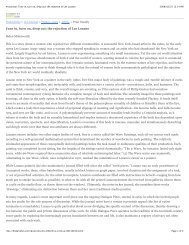The New Spirit of Capitalism - Dark Matter Archives
The New Spirit of Capitalism - Dark Matter Archives
The New Spirit of Capitalism - Dark Matter Archives
Create successful ePaper yourself
Turn your PDF publications into a flip-book with our unique Google optimized e-Paper software.
15remain legitimate, they must incorporate a response to this criticism. This can either consist<strong>of</strong> showing how the criticism is wrong (in which case convincing evidence must be provided)or else it can involve tightening up the test’s control, cleaning it up in such a way as to ensurethat it is more in line with the underlying fairness model. This is what happens, for example,when following a series <strong>of</strong> criticisms an examination that had originally borne the names <strong>of</strong>the people being tested becomes an anonymous one.However, there is another possible reaction to the corrective criticism <strong>of</strong> a test. Thisconsists <strong>of</strong> trying to circumvent this criticism instead <strong>of</strong> answering it. It may be in the interest<strong>of</strong> a certain number <strong>of</strong> actors for the test to lose some <strong>of</strong> its importance, i.e., for it to becomerelatively marginalised, especially if it becomes too difficult to answer criticisms that areconstantly being renewed and which therefore force the test organiser to tighten it up andincrease its total cost. In lieu <strong>of</strong> a direct criticism <strong>of</strong> these institutionalised tests, a propositionthat would be too expensive (above all in terms <strong>of</strong> legitimacy), they end <strong>of</strong> having to look forsources <strong>of</strong> pr<strong>of</strong>its that are new and based on displacements which are local, <strong>of</strong> littlesignificance, not very visible and multitudinous.<strong>The</strong>se displacements can be geographic in nature (delocalisation towards regionswhere workers are inexpensive and where labour law is underdeveloped and/or rarelyrespected). One example would be where companies decide that they do not want to improvethe breakdown <strong>of</strong> revenues between wages and pr<strong>of</strong>its, if this is what critics are demanding.Environmental legislation provides an analogous situation. Another example would be afirm’s modification <strong>of</strong> its career-related criteria for success after it has decided either tocircumvent its customary career management procedures or else to eliminate formal(graphological, psycho-technical etc.) testing during its recruitment process - actions that are<strong>of</strong>ten seen as being too expensive.Another consequence <strong>of</strong> this new type <strong>of</strong> reaction to criticism, involving the use <strong>of</strong>displacement, is that it temporarily disarms criticisms by presenting critics with a world thatthey no longer know how to interpret. <strong>The</strong> criticisms and systems <strong>of</strong> criticism that areassociated with a previous spirit <strong>of</strong> capitalism are barely relevant to new forms <strong>of</strong> testing thathave not yet been subjected to any attempts at recognition, institutionalisation, codification orcategorisation. This is because one <strong>of</strong> the primary tasks <strong>of</strong> criticism is in fact to identify themain tests <strong>of</strong> a given society, and to clarify and/or incite protagonists to clarify the principlesunderlying these tests so that it is subsequently possible to carry out a corrective or radical(reformist or revolutionary) criticism - depending on which options are available at the time,and on the strategies <strong>of</strong> the persons who are involved.Criticism can thus impact testing in several ways.1) It is the role <strong>of</strong> criticism to identify those tests that are truly important to a society byexposing its "tests <strong>of</strong> strength" in broad daylight. Here criticism proceeds bycategorisation, that is, by organising a series <strong>of</strong> individual situations that are shown (bythe criticism) to have something in common – in this instance, the fact that they determinepeople’s position in society, and thus their comparative social value.2) Criticism <strong>of</strong> the tests’ format can purify the tests (tighten them up) in terms <strong>of</strong> the fairnessthat they embody. <strong>The</strong> purpose is to ensure that strengths that should not feature in the testare not in fact a part there<strong>of</strong> - or else to promote the implementation <strong>of</strong> procedures andregulations that make the test fairer.



